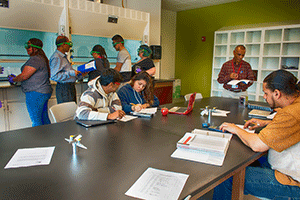
MISSION STATEMENT
The mission of the department is to provide comprehensive and rigorous physics and chemistry curricula that enable students’ successful transition to careers and/or associate and bachelor’s degree programs. Our department uses inclusive pedagogy as a framework to consider practice and students enables to create "living educational theory"; that meets the needs of students and builds their students” (Teemant & Pinnegar, 2019).
COURSES OFFERED
|
ASTRONOMY 201 |
CHEM 121 |
CHEM 201 |
CHEM 203 |
|
CHEM 205-1 |
CHEM 207-1 |
GEOLOGY 201 |
PHY SCI 101 |
|
PHY SCI 107 |
PHY SCI 111 |
PHYSICS 131 |
PHYSICS 221 |
Department Learning Outcomes
Upon completion of courses in our department, students will be able to:
- Describe and explain fundamental concepts in the core areas of Physical Sciences (Chemistry, Physics, Geology, Astronomy).
- Interpret scientific data and apply scientific principles to contextual problem solving.
- Explain the objectives of experiments (Chemistry, Physics, Geology), carry out procedures using standard laboratory equipment and instrumentation, record data, and analyze results.
- Practice necessary safety protocols, including use of personal protective equipment (PPE) and proper chemical handling and waste disposal.
- Communicate the results of scientific work in multiple formats to both the scientific community and the public.
ORGANIZATIONS AND PARTNERSHIPS
Physical Sciences Faculty Directory
Department Chair:
Gabriel Espinosa Martinez, Instructor
Office: 2401-M / gespinosamartinez@ccc.edu
Faculty:
Office: 2401-016 / ymarcano1@ccc.edu
